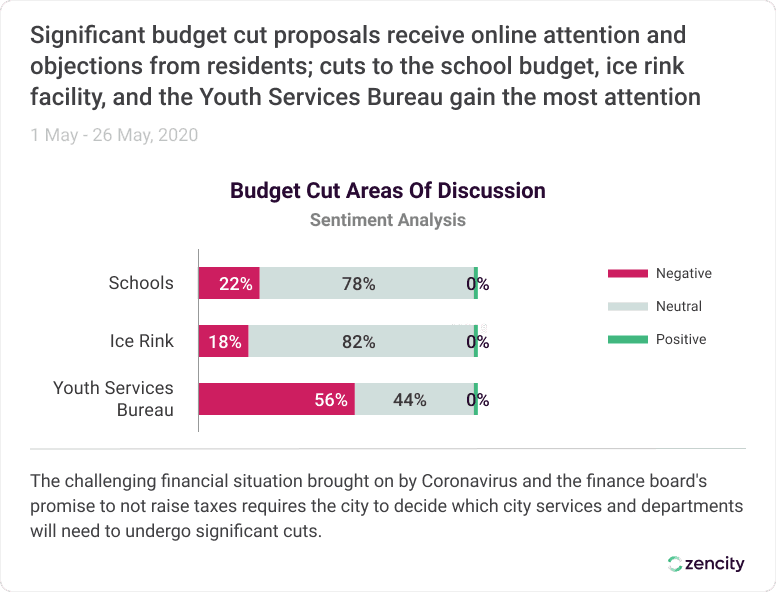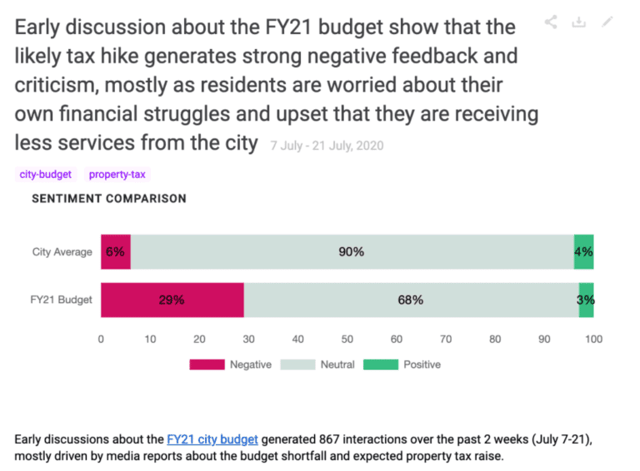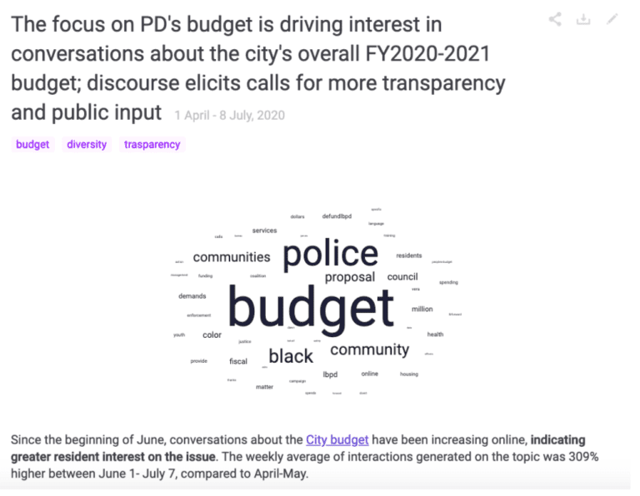It’s All About the Money? How Local Governments are Listening to their Residents to Solidify their FY21 Budget

Assaf Frances
Director of Marketing and Partnerships
What is the Zencity data telling us?
As budget shortfalls impact cities and counties across the country, residents of many local authorities are voicing their opinions and concerns on the matter online. Zencity data indicates residents’ tend to prioritize education and youth programs while citing a need for a more transparent and accessible budget.
Curious to learn where your residents’ priorities lie? Get in touch.
Nearly 9 in 10 US cities are experiencing a budget shortfall due to the impact of the COVID-19 pandemic on their economies. With a projected $360 billion revenue loss over the next three years, unexpected expenditures and little federal support, local governments need to strategize the use of their budgets effectively in order to continue to provide their communities with services that address their needs. Additionally local governments are facing unavoidable tax hikes to help make up for lost income, leading many residents to further voice their concerns and discontent online.
On top of all that, unlike ever before, recent protests across the nation have sparked resident interest in their city budgets, particularly regarding police and public safety. This budding interest has resulted in local authorities considering a more transparent and accessible approach to their budget proposals.
While there is no clear cut solution for city and county leaders to ensure their residents are satisfied with their budget planning, the ability to hear your residents’ voices and address them in an understanding and transparent manner is of the utmost importance in times like these.
Citizen Engagement and Drivers of Discourse
July 1 signified the start of the fiscal year for the majority of local governments, and many local government leaders have already made unavoidable cuts and adjustments in anticipation of their expected losses over the next few years. With revenue for municipalities generally made up from federal and state governments, municipal fees, and property, sales and income taxes, it is crucial for local authorities to consider their residents’ preferences and standpoints.
Working with over 150+ local governments across the US, Zencity was able to identify where budget-related discourse was on the rise, or took an interesting turn. Following that, we provided those cities and counties with analysis and insights that highlight the relevant online public discussions and residents’ reactions to their local government’s proposed budget cuts.
A Zencity Insight for a City in CT

The finance board in one Connecticut city promised to not raise taxes as a result of the pandemic, requiring the city to decide which city services and departments will need to undergo significant cuts. After analyzing related residents’ online discussions, the city found that there was greater dissatisfaction with some areas of proposed cuts over others.
- In response to the proposal of funding cuts to schools, online protests erupted with negative sentiment towards the motion paramount. Similarly, when the local leadership discussed cutting funds to the Youth Services Bureau, this proposition received the highest share of negative sentiment, with residents expressing how huge of a loss it would be to the community.
- However, budgetary cuts to the local ice rink received the least amount of objection from residents, indicating that recreational and seasonal services are a good place to start cutting costs.
A Zencity Insight for a City in FL

Mostly driven by media reports about the budget shortfall and expected property tax raise, residents of a major Florida city voiced their opposition online. Notably, high negative sentiment was approximately 10X times higher than that of positive.
- Many of the critical comments expressed anger that taxes were raised while residents are struggling financially or that residents have to pay higher taxes while receiving fewer services from the city (schools, in particular, were mentioned). In addition, residents demanded that city employees and politicians take a pay cut and that the city be opened back up.
A Zencity Insight for Cities in CA & MA

In light of the current climate in the U.S. towards public safety, specifically as it relates to police departments, many local governments are using police departments as their starting point to make cuts to their FY21 budgets. Despite being on opposite ends of the country, Zencity insights from two cities in California and Massachusetts show similar data trends.
- Both cities saw an increase in engagement around the topic of defunding their police departments. Many offered an alternative to shift funds from the police departments to areas in education, housing, employment and general city services.
- Calls for more transparency and community engagement, as well as questions about how the city budget works were prevalent in both MA and CA.
- In both instances, calls for transparency, public engagement, and interest in line items suggest that the heightened concern about the police budget drove further demands for these cities to ensure their budgets align with resident preferences and are made available to them to review and engage on.
Transparency and Engagement Can Lead to Trust
As the examples above indicate, a recurring theme in resident discourse around budget, are requests to make it more transparent, accessible and legible. Across the country, cities which have taken that approach, such as Philadelphia, Oakland, New York City and others, are more likely to gain their residents’ trust and understanding towards what are sure to be difficult budget years ahead. An even more advanced approach most commonly known in Paris is that of participatory budgeting under which residents of all ages get to engage and vote on how a certain portion of their city’s budget will be spent.
A Data-Driven Approach to Budgeting
Understanding your residents top needs and priorities is critical when outlining the coming years budget. Receiving real-time, ongoing resident discourse data can help to not only back decisions regarding budgeting but also track how these adjustments directly affect the community using sentiment analysis. This allows city and county leaders to respond more proactively to issues that arise and ensure their residents understand the unavoidable hardships of balancing cuts with the continuous provision of quality services.
Find out how this Zencity assessed resident sentiment regarding COVID-19 restrictions, enabling them to strategize effectively, confident in their alignment with residents’ needs.
%20copy-1.png?width=544&height=120&name=Logo_black%20(1)%20copy-1.png)



